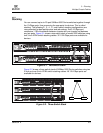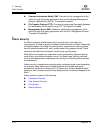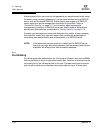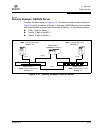
3 – Planning
Fabric Security
3-16 59096-04 A
S
Common Information Model (CIM): Provides for the management of the
switch through third-party applications that use the Storage Management
Initiative–Specification (SMI-S). The default is enabled.
File Transfer Protocol (FTP): Provides for transferring files rapidly between
the workstation and the switch using FTP. The default is enabled.
Management Server (MS): Enables or disables the management of the
switch through third-party applications that use GS-3 Management Server.
The default is disabled.
3.7
Fabric Security
An effective security profile begins with a security policy that states the
requirements. A threat analysis is needed to define the plan of action followed by
an implementation that meets the security policy requirements. Internet portals,
such as remote access and E-mail, usually present the greatest threats. Fabric
security should also be considered in defining the security policy.
Most fabrics are located at a single site and are protected by physical security,
such as key-code locked computer rooms. For these cases, security methods
such as user passwords for equipment and zoning for controlling device access,
are satisfactory.
Fabric security is needed when security policy requirements are more demanding:
for example, when fabrics span multiple locations and traditional physical
protection is insufficient to protect the IT infrastructure. Another benefit of fabric
security is that it creates a structure that helps prevent unintended changes to the
fabric.
Fabric security consists of the following:
Connection Security
User Account Security
Port Binding
Device Security


















